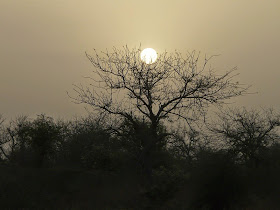This completes a posting I began here earlier in the week. I'd always meant to feature Waza National Park in the far north of Cameroon at some stage, following a visit in 2008, but I was prompted to do so now by the news of a murderous attack on a local bus by Boko Haram combatants crossing the nearby border from Nigeria on New Years Day. This follows earlier kidnappings by them of French tourists and Chinese engineers. These events have effectively closed the park and area to visitors for the imaginable future, cutting off a valuable source of income to locals.
This is my tribute to those people and a magnificent park which deserves to be seen and supported. I may not see the day that adventurous nature lovers drive into it again, but I'm sure that the day will eventually come.
Deep in the Sahel - that vast belt of arid woodland which blends into the Sahara to the north - Waza is dry, dusty and hot, but full of life. Accommodation is in traditional round huts on a rocky hill overlooking the park, by the village of Waza.
 |
| View of the accommodation from the plain, behind a herd of Korrigum Damaliscus korrigum (a threatened species of limited distribution, formerly regarded as a subspecies of Topi D. lunatus). |
 |
| The reverse view over the plain, from the restaurant balcony. |
 |
| My cabin; basic but comfortable. |
The habitat that I saw - and with 170,000 hectares to explore, there was much that we missed - was dominated by deciduous acacia woodland with a grassy understorey.
 |
| Typical habitat; below, the deciduous nature of some of the trees, and the grassy understorey, are more evident. |
There are 30 mammal species recorded for the park - including lion and elephant - but we only saw a few, not being there in the evening or night.
 |
| Korrigum herd; Waza is a stronghold of these antelope, which apparently number less than 2500 animals. (The haze that renders murky many of these pictures is evident here. Dust or smoke, I can't say.) |
 |
| Roan Antelope Hippotragus equinus, one of the largest antelopes at up to 300kg. |
 |
| Patas Monkey Erythrocebus patas, a largely ground-dwelling monkey of the Sahel. |
 |
| Warthog Phacochoerus africanus. |
Even in the morning, before temperatures began to seriously rise, the waterholes were attracting many birds.
 |
| Helmeted Guineafowl Numida meleagris; found across sub-Saharan Africa, and a personal favourite. |
 |
| Knob-billed Ducks Sarkidiornis melanotos have a remarkable distribution across Africa, southern Asia and South America, but are never common and I was glad to see these. |
A real thrill for me was a close-overhead flyover of a small flock of the magnificent Black Crowned Cranes.
Other bush birds were not so tied to the waterholes.
 |
| Vieillot's Barbet Lybius vieilloti, another Sahel special. African barbets are regarded now as quite separate from their American namesakes. |
 |
| Abyssinian Roller Coracias abyssinicus, one of the common birds of the Sahel, but not one I could ever tire of. |
I've felt that we've been a bit cheated with regard to starlings in Australia; we have only one native species, with a very small tropical range, and two widespread (and not especially colourful) aggressive exotics. Africa always reminds me of the alternatives!
 |
| Greater Blue-eared Glossy Starling Lamprotornis chalybaeus (what an immodest collection of adjectives!) is much more widespread than the next starling. |
 |
Chestnut-bellied Starling Lamprotornis pulcher, yet another Sahel specialist, and an attractive one again. |
And as I've suggested before, the day became hot (high 30s anyway), and the birds were dealing with it in their various ways.
 |
| African Swallow-tailed Kite Chelictinia riocourii, holding its wings out, hoping for a scrap of breeze to cool it. |
Gasping to allow evaporation from inside mouths and throats was popular.
 |
| Ethiopian Swallows Hirundo aethiopica. |
 |
| White-throated Bee-eaters Merops albicollis breed in the Sahara itself, and come this far south for winter. |
 |
| African Silverbills Lonchura cantans hung about in the shade near the accommodation, but still did their share of panting. |
So, Waza, one of those places that for most of us we only hear of when it's too late. I was just lucky, and I'm so glad I was.
I'll go on thinking about it, and its fate, for a long time.
 |
| There'll be many such Waza sunsets through the thorn trees long after we've stopped making a mess of things. |
BACK ON THURSDAY




No comments:
Post a Comment